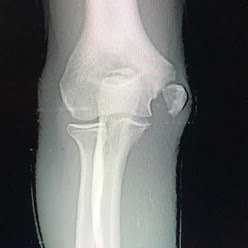This post is addressed to USA Baseball, MLB and every single little & amateur league in the world.
I want to share a little bit of my experience and research in the International Market, mainly, Latin America; where 4 out of every 7 pitchers is being affected by arm injuries during their development. This is a Epidemy.
Growth plates are being break by irrational use of kids arms
This awful injurie is ending what would be promising baseball careers.
Little League elbow is a common condition that affects young baseball players who engage in repetitive overhead throwing motions. This condition can result in various presentations, including medial epicondyle fracture, medial epicondylitis, and medial collateral ligament (MCL) injury.
The afore mentioned institutions and professionals have been taking action TRYING to prevent kids get injuries like this, but the problem is that the recommendations (like Pitch Smart) are not being that effective. The number of injured kids is rising year after year and the severity of the injuries is getting worse.
We are talking about 12-14 years old kids getting MCL injury, Tommy John, Medial epicondylitis, or Medial epicondyle fracture.
MCL injury is a sprain or tear of the ligament that connects the medial epicondyle to the ulna bone in the forearm. Symptoms may include pain, swelling, and instability in the elbow joint. Treatment can vary depending on the severity of the injury, but often involves a period of rest and physical therapy. In more severe cases, surgery may be necessary to repair the damaged ligament.
Medial epicondylitis is an inflammation of the tendons that attach to the medial epicondyle, which is caused by repetitive overuse of the elbow joint. Symptoms include pain and tenderness on the inside of the elbow, weakness in the forearm, and limited range of motion. Treatment typically involves rest, ice, anti-inflammatory medications, and physical therapy.
Medial epicondyle fracture occurs when there is a break in the bony prominence on the inside of the elbow, where the MCL attaches. This injury is the most severe of the three conditions and requires surgical intervention in some cases. In particular, if the fracture is displaced, a surgical screw or nail may be required to reattach the broken piece. Recovery from surgery can be prolonged and may include several months of physical therapy to regain full strength and range of motion. Moreover, surgery to repair a medial epicondyle fracture can result in a reduced chance of passing the physical evaluations required to sign with an MLB team.
So, to prevent little league elbow, it's crucial to take take better preventative measures, such as POSTURAL ASSESSMENTS, SUPERVISED TECHNICAL/BIOMECHANICAL ADJUSTMENTS, monitoring pitch counts and EFFORT LEVELS, ensuring proper rest, nutrition and recovery measurements at the right time. As I said before, Pitch Smart is an incomplete guide for parents and coaches to protect the health of young baseball players. It fails to acknowledge the full scope of the problem and not provide enough information to prevent these types of injuries.
Pitch Smart recommends rest as a solution to mitigate injury risk, but it fails to acknowledge that too much rest can worsen the problem by causing muscle weakness and negatively impacting a player's throwing mechanics, consistency, and coordination. Therefore, it's essential to factor in long toss and in-game throws from any position when discussing the throwing stress/rest equation.
Moreover, a kid can throw 100 baseballs and do elastic band exercises 2 times a week without risking injury, if they do it at 50% of their maximum effort or at a certain speed and proper throwing mechanics.
This approach will help them better to prevent injuries by strengthen the muscles while keeping the mechanics healthy, and the level of effort will remain below dangerous levels. Taking care of the effort and stress placed on the elbow is critical to prevent little league elbow. Thus, parents and coaches should ensure that young baseball players receive appropriate training and guidance to prevent injuries that could have long-term consequences on their lives/careers.
It is crucial to take care of: Postural issues, Mechanics, Nutrition and Effort Levels, to prevent injuries in kids.
If you want to have a diagnostic evaluation of your kid, feel free to reach out at: performance.optimization@tacticsnr.com





Comentarios
Publicar un comentario